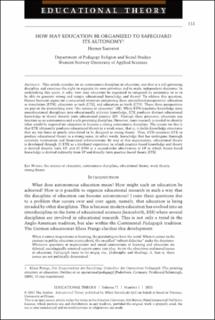| dc.description.abstract | This article searches for an autonomous discipline of education, one that is a self-governing discipline and exercises the right to organize its own activities and to make independent decisions. In undertaking this quest, it asks: how may education be organized to safeguard its autonomy so as to be able to generate strong and unique educational knowledge and theory? To address this question, Herner Saeverot argues for a conceptual structure comprising three interrelated perspectives: education as translation (ETN), education as task (ETK), and education as truth (ETH). These three perspectives are part of the overarching term “the science of education” (SE). While ETN translates knowledge from noneducational disciplines into educationally relevant knowledge, ETK produces distinct educational knowledge or theory directly from educational practice (EP). Through these processes, education can function as an autonomous and a self-governing discipline. However, more research is needed to identify what would be required for education to become a strong autonomous discipline. The reason for this is that ETK ultimately produces educational theory in a weak sense, that is, it yields knowledge structures that are too loose or poorly articulated to be designed as strong theory. Thus, ETH examines ETK to produce educational theory in a strong sense, in other words, knowledge that has undergone thorough scientific verification and theoretical substantiation. By way of this organization, educational theory is developed through (1) ETK as a firsthand experience in which practice-based knowledge and theory is derived directly from EP, and (2) ETH as a second-order observation of EP in which theory-based knowledge is derived indirectly from EP and directly from practice-based theory (ETK). | en_US |

